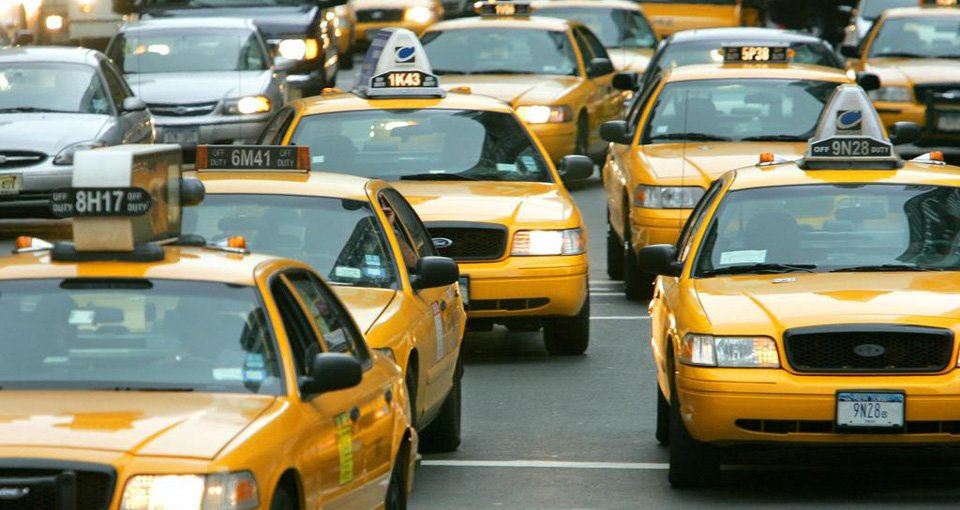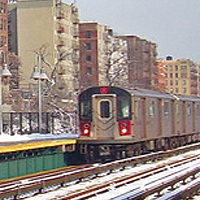
The utter chaos that has engulfed New York City’s taxi industry should be clear to anybody who spends any time at all on the streets. Uber, Lyft, and many other car services pack every street, competing for business with yellow cabs, green cabs, and assorted independent and semi-independent “gypsy” outfits. There is no longer any enforcement or control and other services blatantly pick up passengers in areas supposedly reserved for the licensed yellow cabs only. The ultimate effect of all of this is to drive down the standards of the drivers while enriching the transportation giants.
Even a superficial investigation of the NYC taxi industry will yield some fascinating insights. In a sense, the entire trajectory of capitalism – from initial accumulation to its eventual collapse – is revealed by it. A study of the taxi industry also illustrates the importance of context – what is, superficially, the same may have different content in terms of how it relates to the masses of working people. Thus, a system administered by a progressive city government – one that, primarily, has the interest of the masses of working people in mind – will produce outcomes with different content then that same system under an administration whose main interest is in looking out for the welfare of the rich and powerful few.
Such is the case in the NYC taxi industry, as a survey of its historical development will show. This is a big and complicated issue, but here we will try to take a brief look at the way that the NYC taxi industry arrived at its present state of chaos.
Taxi licenses and the medallion system
Some time ago —in the 1930’s — New York City came up with an idea to provide opportunities for people to work for themselves. In 1937, Mayor Fiorello H. La Guardia, a socialist, then the progressive mayor of NYC, signed the Haas Act which introduced an official taxi licenses and the medallion system, a system that remains in place until today. The city issued “medallions” which could be purchased by individuals as well as by big fleets and established the “hack bureau” to police and control the industry. Although the act preserved the existing “for profit” system, it also looked out for the welfare of the working people by insuring that there would always be a distinction between “fleet” medallions and “individual” medallions. Certain regulations and restrictions were placed upon the medallions issued, which varied depending on the type of medallion (individual or fleet).
Because of these restrictions and regulations, the price of each type of medallion was quite different, although over the years these distinctions, (and the difference in price), have faded. Back “in the day,” individual medallions had to be operated by the person who owned it. On the other hand, fleet medallions had to be owned by a corporation and were not subject to this restriction. The medallions were originally issued at a cost that was quite reasonably – about $43,000 in today’s dollars – in the realm of what a working person, with some financial backing, could afford.
The idea was to make it possible for working people to make a modest but decent living and to build up some personal wealth through the appreciation of the medallion – wealth that could then serve as a retirement “nest egg” or which could be passed on to descendants. This legislation, which in no way threatened the existing system of social organization was, nevertheless, structured in such a way that the welfare of working people was not only protected but even promoted. This is an illustration of the difference a political administration can make, even within a capitalist system. In those days, the regulated taxi industry of New York City represented a good way for a person to not only “own” their business but enjoy the fruits of being self-employed: making one’s own hours of work, taking a break when needed, not having to ask for permission, etc.
Although, as has been said, there were certain regulations related to the use of the medallions, in practice, (and in this you can see the germ of future abuse – although it was not at all clear at the time), despite the regulations some owners of individual medallions made informal agreements with friends or family who would operate the cab during the owners off hours, many times under some kind of leasing arrangement. This relationship, although benign and perhaps even favorable to the individual leasing the cab, bore the seeds of the abusive relationship that was to grow out of it.
Taxi workers get a union
Although the early legislation did provide for “individual” medallions, most drivers worked for big fleets and, over the years, there were attempts to organize workers. Finally in 1965, after many failed attempts, taxi workers got a union. However, it eventually succumbed, a victim of subsequent developments in the industry. It wasn’t until 1998 that an organization of workers in the industry was reborn: New York Taxi Workers Alliance, which now has a membership of some 18 or 19 thousand. Taxi workers nationally, organized into the National Taxi Workers Alliance, have been recognized by the AFL-CIO even though they are considered contractors and not workers. But now back to how we got to this point.
In the early 1970’s, there was a development that would prove to be catastrophic to the cities taxi industry – the arrival of the “mini” fleet. Some background is necessary. Traditionally, for liability reasons, the big fleets organized themselves into many small companies that only owned a few cabs each – thus a fleet of, say, 200 cabs might actually be organized into 100 separate companies. Well, what happened is that some sharp operator bought up all the medallions held by a fleet in the Bronx and began selling them as “mini” fleets. This parasite would bring together people who wanted an “individual” medallion but either could not afford the price or wanted a bargain. Two people would then form a corporation of convenience which would, ostensibly, own the medallions but the “officers” of this corporation would operate them as if they were individual medallions (the “corporation” just being on paper). This was an obvious attempt to subvert the law, but the city administration then in power let this happen. It not only led to a decline of two thirds in the membership of the taxi drivers’ union, but it also was the beginning of the end for the taxi industry in NYC.
The decline of the industry
The next step in the decline of the industry was taken in the later part of that decade, with the legalization of leasing. Previously, most cab drivers who didn’t own their own medallion worked on a percentage system, splitting each day’s take with the medallion owner, usually a big fleet. That way, if the driver had a “bad” day, the boss had one too. But a city administration that was, at the least, not well grounded politically, allowed the leasing system, which had thus far been illegal in NYC. This system, already widespread in other locales, allowed the owners of fleet medallions to charge drivers a lease fee rather than getting a percentage of the take, and to classify them as independent contractors rather than as employees.
Like so many other things, this may have started off benignly and allowed drivers to make more then what they might have under the old percentage system, but the seeds of abuse here were clear. As lease rates went up, drivers made less and less and the fleets, who now never had a bad day, made more and more. In the end, it not only impoverished the drivers but was the final nail in the coffin of their union. Today most yellow taxi medallions are operated by large companies which rent out medallions to drivers who are sometimes even forced to buy and maintain their own cars.
In December of 2011, another blow came to the people working in the NYC taxi industry. Billionaire Mayor Michael Bloomberg, with the full support of New York State Gov. Andrew Cuomo, pushed through a law that allowed the issuance of 18,000 new taxi permits for “green cabs,” which were ostensibly restricted to the outer boroughs. The pretext for this was to provide better service to boroughs outside Manhattan, but this was just an excuse; the real reason was to provide another avenue for profit to the rich and well connected.
Transportation behemoths arrive
This series of moves, taken together, led to the current sorry state of the industry. The days when owning a medallion was a path to the middle class and some financial stability are gone, but to make matters worse, transportation behemoths like Uber, Lyft, and many other ridesharing services came to feed off the working people of NYC.
The city’s mayor, Bill de Blasio – quite likely the most progressive mayor to hold office since LaGuardia – tried, for a while, to keep the big transportation conglomerates out of NYC, but he was resisted, even by apparently progressive members of the city council, who were somehow swayed by companies like Uber and its lobbyists.
Now, with all the competition, it is extremely difficult for yellow or even green cab drivers. The situation is so bad that recently it has been reported that because of the saturation of Uber and Lyft drivers throughout the city, many of the 18,000 TLC permits that could be issued for green cabs have gone begging. Meanwhile, attempts to rationalize the situation, for instance to limit the number of Lyft drivers, have failed.
The fallout from the destruction of the taxi industry extends well beyond the direct welfare of the drivers. Because of the changes over time, and the consequent sharp decline in the value of the medallion, many medallion holders who borrowed heavily to buy them now can’t pay their loans. This has, in turn, had a negative impact on the institutions that have, traditionally, provided the financing.
As reported in Crain’s NY Business of July 10, 2017, the Melrose Credit Union, based in Queens, which holds much of the outstanding medallion secured debt, is teetering on bankruptcy. The case of Melrose could be seen as emblematic of what has happened in the industry. Once a small company that mainly was limited to making loans secured by NYC taxi medallions, it was caught up in the deregulation frenzy of the 70’s.
As is often the case, the true nature of this was not immediately apparent to the powers that be at Melrose – at first, they rejoiced at having been freed from the restrictions imposed on such institutions and, for a while, Melrose prospered. Eventually, of course, things developed in the direction that they always were headed, and Melrose, just one of many “small timers,” paid the price.
The taxi industry suffers from much of the same problems that plague our society in general; that is, the lack of jobs for millions seeking gainful employment. Millions of jobs that paid a living wage have disappeared due to the global economy.
Is there a solution to this dilemma? That’s the big question.
Much of the research for this piece was done by Gabe Falsetta. Gary Bono, a former New York City cab driver, wrote based on his experience and general knowledge of the industry.










